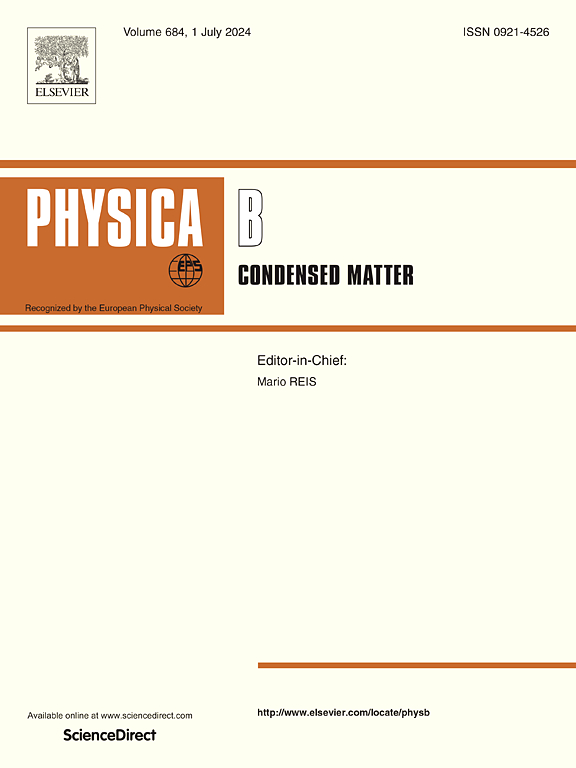Co-doping of Mn and Cr in CdTe thin films: Tunable white light emission and structural stability
IF 2.8
3区 物理与天体物理
Q2 PHYSICS, CONDENSED MATTER
引用次数: 0
Abstract
Mn and Cr co-doped CdTe thin films were synthesized using the radio frequency (RF) sputtering technique on (001) GaAs substrates. Comprehensive investigations were conducted to evaluate the structural, morphological, vibrational, and optical properties of the resulting films. X-ray diffraction (XRD) analysis confirmed that the doped CdTe thin films retained a cubic zinc blende crystal structure, indicating the successful incorporation of Mn and Cr ions into Cd lattice sites. Surface morphology and elemental composition were assessed through high-resolution scanning electron microscopy (HR-SEM) and energy-dispersive X-ray spectroscopy (EDS) mapping. The films exhibited a smooth, uniform morphology, which remained consistent across varying dopant concentrations, signifying stable film growth. Fourier-transform infrared (FTIR) spectroscopy was employed to identify functional groups present in the films, while Raman spectroscopy provided insights into the intrinsic vibrational modes associated with the CdTe lattice. Photoluminescence (PL) measurements revealed characteristic blue and green emission bands, with prominent peaks observed at 433 nm and in the 512–525 nm range, respectively. The peak shifting corresponds to the energy transitions involving Mn2+ and Cr2+ dopant levels. The Commission Internationale de l'Eclairage (CIE) 1931 chromaticity coordinates for the Mn-doped CdTe films were determined to be (0.30, 0.33), closely approximating pure white light emission. The co-doped films displayed white light emission with a subtle blue shift, and the corresponding correlated color temperature (CCT) was calculated to exceed 5000 K, situating the emission in the cool white light region. These results suggest that Mn, Cr co-doped CdTe thin films possess significant potential for use in optoelectronic devices, particularly in light-emitting diode (LED) applications.

锰和铬在CdTe薄膜中的共掺杂:可调白光发射和结构稳定性
采用射频溅射技术在(001)GaAs衬底上制备了Mn和Cr共掺杂CdTe薄膜。对所得薄膜的结构、形态、振动和光学性质进行了全面的研究。x射线衍射(XRD)分析证实,掺杂后的CdTe薄膜保留了立方锌闪锌矿晶体结构,表明Mn和Cr离子成功掺入到Cd晶格位。通过高分辨率扫描电镜(HR-SEM)和能量色散x射线能谱(EDS)作图评估表面形貌和元素组成。薄膜表现出光滑、均匀的形态,在不同的掺杂浓度下保持一致,表明薄膜生长稳定。傅里叶变换红外光谱(FTIR)用于识别薄膜中存在的官能团,而拉曼光谱则提供了与CdTe晶格相关的固有振动模式的见解。光致发光(PL)测量显示出特征的蓝色和绿色发射带,分别在433 nm和512-525 nm范围内观察到显著的峰。峰移对应于Mn2+和Cr2+掺杂水平的能量跃迁。根据国际发光委员会(CIE) 1931的色度坐标测定,mn掺杂CdTe薄膜的色度坐标为(0.30,0.33),接近纯白光发射。共掺杂薄膜显示白光发射,伴有轻微的蓝移,计算出相应的相关色温(CCT)超过5000 K,发射处于冷白光区。这些结果表明,Mn, Cr共掺杂CdTe薄膜在光电器件,特别是发光二极管(LED)应用中具有重要的应用潜力。
本文章由计算机程序翻译,如有差异,请以英文原文为准。
求助全文
约1分钟内获得全文
求助全文
来源期刊

Physica B-condensed Matter
物理-物理:凝聚态物理
CiteScore
4.90
自引率
7.10%
发文量
703
审稿时长
44 days
期刊介绍:
Physica B: Condensed Matter comprises all condensed matter and material physics that involve theoretical, computational and experimental work.
Papers should contain further developments and a proper discussion on the physics of experimental or theoretical results in one of the following areas:
-Magnetism
-Materials physics
-Nanostructures and nanomaterials
-Optics and optical materials
-Quantum materials
-Semiconductors
-Strongly correlated systems
-Superconductivity
-Surfaces and interfaces
 求助内容:
求助内容: 应助结果提醒方式:
应助结果提醒方式:


